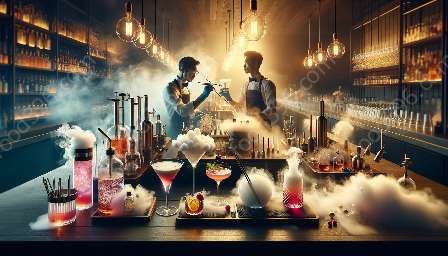When it comes to the art of molecular mixology, foam and spherification techniques are at the forefront of innovative mixology practices. To master these techniques, mixologists rely on a range of specialized tools and equipment that are designed to create captivating textures and flavors. In this comprehensive guide, we will delve into the world of molecular mixology, explore the tools and equipment essential for foam and spherification, and uncover the intricate process behind these cutting-edge methods.
Understanding Molecular Mixology
Molecular mixology, a branch of mixology that emphasizes the use of scientific principles and techniques, has revolutionized the way cocktails and beverages are crafted. By employing molecular gastronomy, mixologists can manipulate the physical and chemical properties of ingredients, leading to the creation of innovative and visually stunning concoctions.
Foam and spherification are two key techniques within the realm of molecular mixology that have gained widespread attention for their ability to elevate traditional cocktails to new heights. These techniques rely on the precise application of specialized tools and equipment to achieve their distinct textures and presentations.
Essential Tools and Equipment for Foam
Creating velvety foam that enhances a cocktail's aroma and mouthfeel requires the use of specific tools and equipment. Foam is often produced through the introduction of nitrogen or other foaming agents into liquid ingredients, resulting in a light and airy texture that adds a layer of complexity to the drink. Some essential tools for foam creation include:
- Nitrogen Chargers: These small, pressurized canisters contain nitrogen gas that can be dispensed into liquid mixtures to create stable foam. With the use of a whipped cream dispenser, nitrogen chargers enable precise control over foam consistency and volume.
- Whipped Cream Dispenser: Equipped with a nozzle and a compartment for nitrogen chargers, a whipped cream dispenser serves as a vessel for mixing liquid ingredients with nitrogen gas to produce foam. The dispenser's pressurized environment ensures the formation of stable foam.
- Flavor Extracts and Emulsifiers: To infuse foam with distinct flavors, mixologists utilize specialized extracts and emulsifiers that can enhance the taste and aroma of the foam while contributing to its stability.
The Art of Spherification
Spherification is a captivating process that involves turning liquid ingredients into delicate spheres, adding both visual appeal and burst-in-your-mouth flavors to cocktails. This technique relies on the precise use of tools and equipment to achieve the desired size, texture, and consistency of the spheres. Key tools for spherification include:
- Sphere Mold: These molds are designed to create uniform spherical shapes from liquid mixtures. Depending on the desired size of the spheres, mixologists can choose from a variety of sphere molds to tailor the presentation of their cocktails.
- Calcium Lactate and Sodium Alginate: These specialty chemicals are fundamental to the spherification process. Calcium lactate is used to create a bath that helps gel the spheres, while sodium alginate forms the outer membrane of the spheres, allowing them to hold their shape while encapsulating flavorful liquids.
- Syringes and Precision Droppers: For carefully portioning liquid ingredients into the sphere molds, mixologists rely on syringes and precision droppers to precisely control the volume and placement of the liquids, resulting in consistently shaped spheres.
Combining Techniques for Innovative Cocktails
While foam and spherification techniques each offer distinct contributions to the world of molecular mixology, savvy mixologists often combine these methods to create truly mesmerizing cocktails. By incorporating foam and spherified spheres in the same drink, mixologists can unlock a new realm of sensory experiences for their patrons.
From the theatrical presentation of foamy cocktails to the captivating burst of flavor from spherified spheres, molecular mixology tools and equipment have enabled mixologists to push the boundaries of creativity and craft. With a deep understanding of these tools and techniques, mixologists can continue to innovate and delight cocktail enthusiasts with their flavorful and visually captivating creations.

